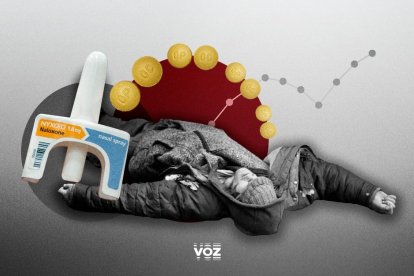Fentanyl, hell in doses: This is how the opioid crisis killed 80,000 people in one year
The history and statistics of an epidemic that has plagued the United States for years and has intensified since 2020.

Cordon Press- AFP
Nearly 40 years ago, an essential label ceased to appear on certain types of pain medications. While seemingly irrelevant, it was the source of a crisis affecting millions of people in the United States. The overdose of opioids, pain-relieving drugs, has become a virtual epidemic in the United States. According to The Economist, it is in its "most lethal" phase due to fentanyl, which is responsible for 70% of annual overdose deaths.
The crisis has recently spiraled out of control, even leading to cases of children being born with withdrawal symptoms due to maternal opioid overdoses during pregnancy.
According to data from the National Institute on Drug Abuse (NIDA), the total number of deaths from opioid overdoses increased by more than 300% in 20 years. While in 1999, the number did not exceed 20,000, by 2021, the number of deaths was 80,411. This figure turned out to be 75.4% of all drug overdose deaths.
In turn, 88% of these opioid overdose deaths were caused by synthetic opioids, such as fentanyl, currently the main culprit in the crisis.
With these numbers, here is the history and impact of the fentanyl crisis in the United States.
What is fentanyl?
Before starting, it is necessary to know what opioids are and how they work. According to the Mayo Clinic website, they are "a broad group of pain-relieving drugs that interact with opioid receptors on cells", which "are distributed through the blood and bind to opioid receptors on brain neurons", releasing "signals that dampen your perception of pain and increase feelings of pleasure."
Among synthetic opioids, i.e., laboratory-made opioids, there is fentanyl, which is up to 50 times stronger than heroin and 100 times stronger than morphine.
There are two types of fentanyl: pharmaceutical and illegally manufactured. While the former is medically prescribed to relieve pain related to operations or illnesses, the latter circulates on the black market and proves to be much more dangerous. Why is this? Because of its extreme potency, traffickers mix it with other substances to make it cheaper and more harmful to the body. It is available in both liquid and powder versions.
The lethal dose for adults is estimated to be 2 milligrams, which is less than the average weight of an ant.
The perfect drug?
So said The Economist, due to the facilities it provides traffickers for its production and distribution.
"In the past, drug running was resource-intensive. Drug gangs needed vast swathes of land on which to grow marijuana or coca, the plant used to make cocaine. Law-enforcement officers could disrupt supply by burning fields of the stuff or dropping pesticides on coca farms. Fentanyl is different. Synthetic drugs can be manufactured by one person in a basement or a tiny flat. That makes finding and destroying such makeshift labs difficult. The drug's small size and potency also make it much easier to transport," they wrote.
In terms of origin, in addition to clandestine domestic production, China, India and Mexico stand out as manufacturers. In the latter case, traffickers often bring the unfinished product into the country and then finish cooking it and sell it illegally.
Fentanyl and the southern border
According to the National Immigration Forum, and based on U.S. Customs and Border Patrol statistics, fentanyl seizures during FY2023 exceeded those of the previous three years.
In turn, compared to FY 2023, fentanyl seizures at the southern border increased by 480% compared to 2020.
How did the opioid epidemic originate?
Before the 1980s, pain relief medications came with a very clear label that read, "May cause addiction."
However, perceptions began to change after two key events. The first was a letter to the editor that appeared in the New England Journal of Medicine, written by Dr. Herschel Jick, who analyzed hospital records with his assistant Jane Porter. They concluded that "despite widespread use of narcotic drugs in hospitals, the development of addiction is rare in medical patients with no history of addiction."
According to them, only 4 of 11,000 people treated with opioids developed addiction. Over the following decades, companies, physicians and academics have cited that letter as purported evidence of a low likelihood of opioid addiction.
This letter to the editor is considered to be the one that opened the door to the opioid crisis.
The second event took place in 1986 and was a study involving only 38 people. It advocated for the use of opioids in the treatment of chronic non-cancer pain.
Despite the scant evidence that both cases presented, they enjoyed unwarranted prominence and ended up encouraging the perception that opioids were not addictive if used to treat chronic pain.
During the same decade, the so-called "pain crisis" caused some states to pass laws allowing doctors to prescribe pain relief drugs without the possibility of being sued later.
The explosion in the 1990s and the birth of OxyContin
These perceptions created in the 1980s were patiently building a powerful explosive, which detonated like a huge shockwave years later. The pro-opioid narrative led to the popularization of Purdue Pharma's OxyContin.
According to Nature magazine, many doctors working in private clinics benefited from increased patient numbers at the time.
Pharmaceutical companies began bombarding viewers with promising advertisements for these drugs. The segmentation was such that they generally showed suburban and rural white people, starring the famous "before and after." Indeed, Purdue Pharma's most popular commercial was dubbed "I got my life back."
The states most affected by the opioid crisis have been West Virginia, Kentucky, Pennsylvania, Arizona, Ohio, Ohio, Indiana, Tennessee, Massachusetts, and Maine, among others.
With the rise of opioid prescriptions increasing in exaggerated numbers, some enterprising patients began reselling the drugs, aiding in their distribution and expanding addictions, leading to the current crisis.
The pandemic as the opioid crisis' best friend
While the trend was already high, The Economist showed a significant jump in the annual number of overdose deaths after the pandemic. According to their analysis, "people were more isolated and cut off from support systems and treatment options."
Fentanyl's impact on crime
As released by the Department of Justice in February 2024, the number of fentanyl-related drug arrests increased by 36% from FY 2020 to FY 2021.
In turn, during this same period, the number of drug arrests the DEA made for fentanyl (3138) surpassed the number of arrests for heroin (2591).
"Beyond the overall increase in fentanyl sentences from FY 2020, looking at regional patterns in FY 2021, sentences imposed for drug offenses involving heroin, fentanyl and other opioids made up a larger share of drug sentences imposed in northeastern states than in other regions," Kevin M. Scott, acting director of the Bureau of Justice Statistics (BJS), said of the increase.
"Most persons sentenced for heroin, fentanyl and other opioids (97%) were sentenced for drug trafficking," he said.
RECOMMENDATION





















